Fiercely spicy, mouth-numbing and super aromatic, Chongqing noodles are one of the most popular street foods of China. Follow my recipe to make it at home!
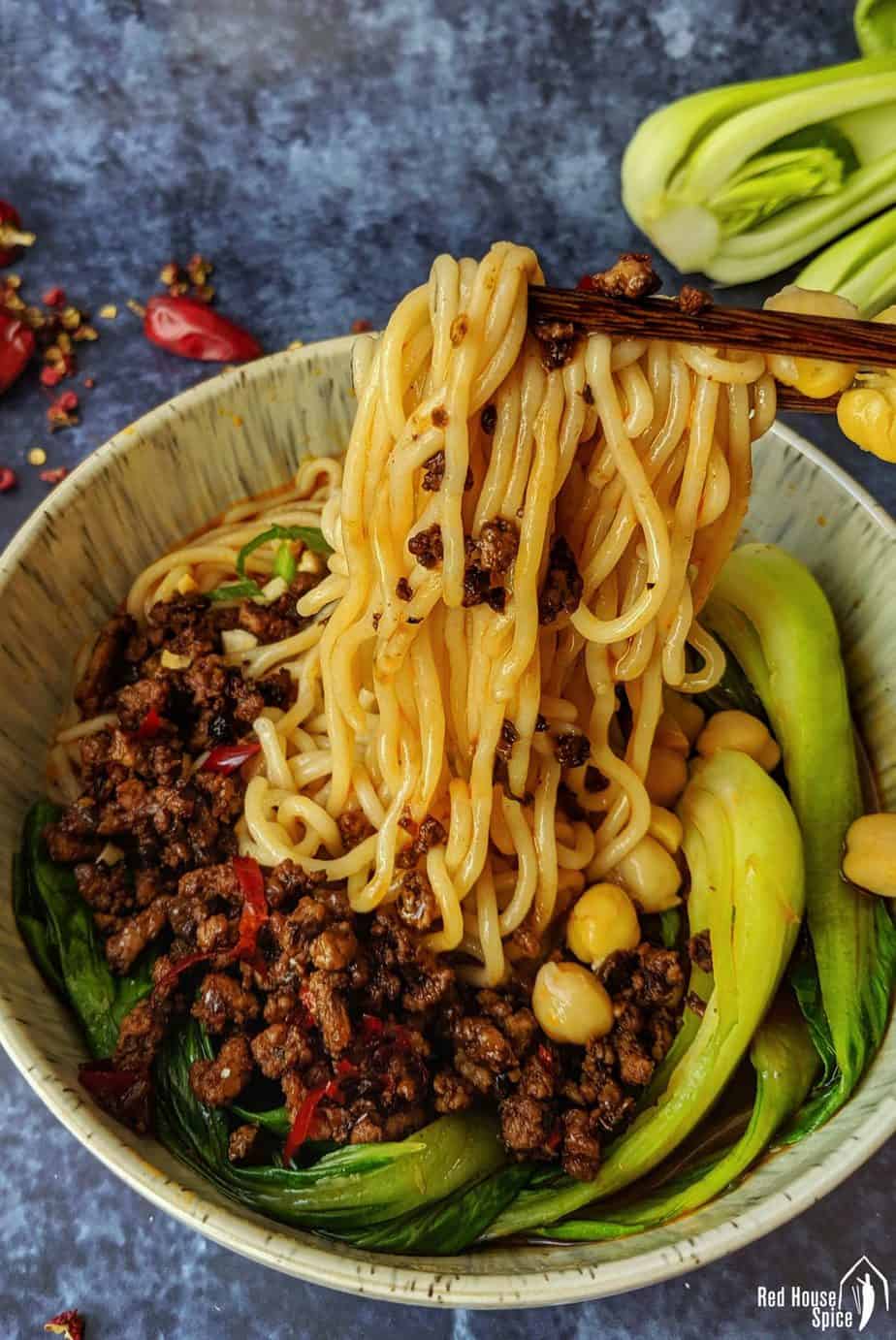
Ever since my visit to Chongqing in April, I’ve been craving Chongqing noodles (Xiáo Miàn, 重庆小面), the signature street food of the city which pushes the Málà (麻辣, hot & numbing) sensation to its extreme. Through further research and kitchen experimentation, I’m now ready to share the recipe for this irresistible dish.
Jump to:
What are Chongqing noodles?
Chongqing noodles is a general term given to a variety of noodle dishes originating from Chongqing, China. They all share the same flavour profile: fiercely spicy, mouth-numbing and super aromatic. If you like Dan Dan Noodles, today’s recipe will definitely please your palate.
Xiǎo Miàn “small noodles”
The Chinese name for Chongqing noodles is Xiǎo Miàn/小面 literally meaning “small noodles”. It signifies the simplicity and humbleness of this everyday dish. Similar to Chinese Sesame Noodles, they are usually served as breakfast or lunch in small neighbourhood cafes.
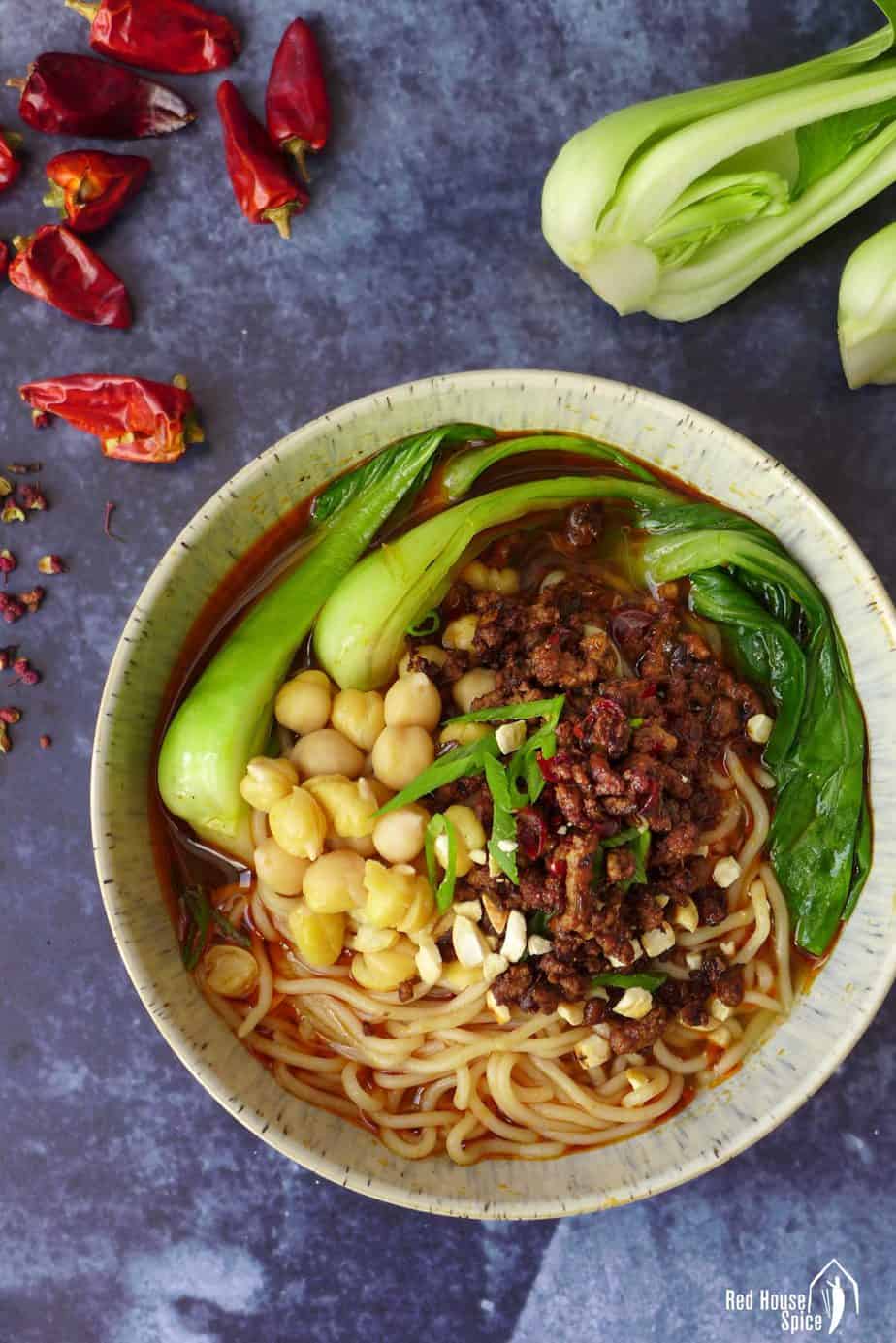
The basic version
The basic version of Chongqing noodles consists of boiled noodles, blanched leafy greens, a well-seasoned broth and toppings like preserved vegetable, roasted peanuts, etc.
Locals call this simple version Sù Miàn (素面) which means “plain noodles”. To add extra taste, it’s a common practice to add a spoonful of lard to the broth. So in most restaurants, it’s not regarded as a vegetarian dish.
How to make the broth
The soul of Chongqing noodles is its distinctive broth. I’d use three Chinese characters to describe the taste: má/麻/numbing, là/辣/spicy and xiān/鲜/umami. Success is guaranteed if you get all the key components spot on.
Make your own Chinese chilli oil
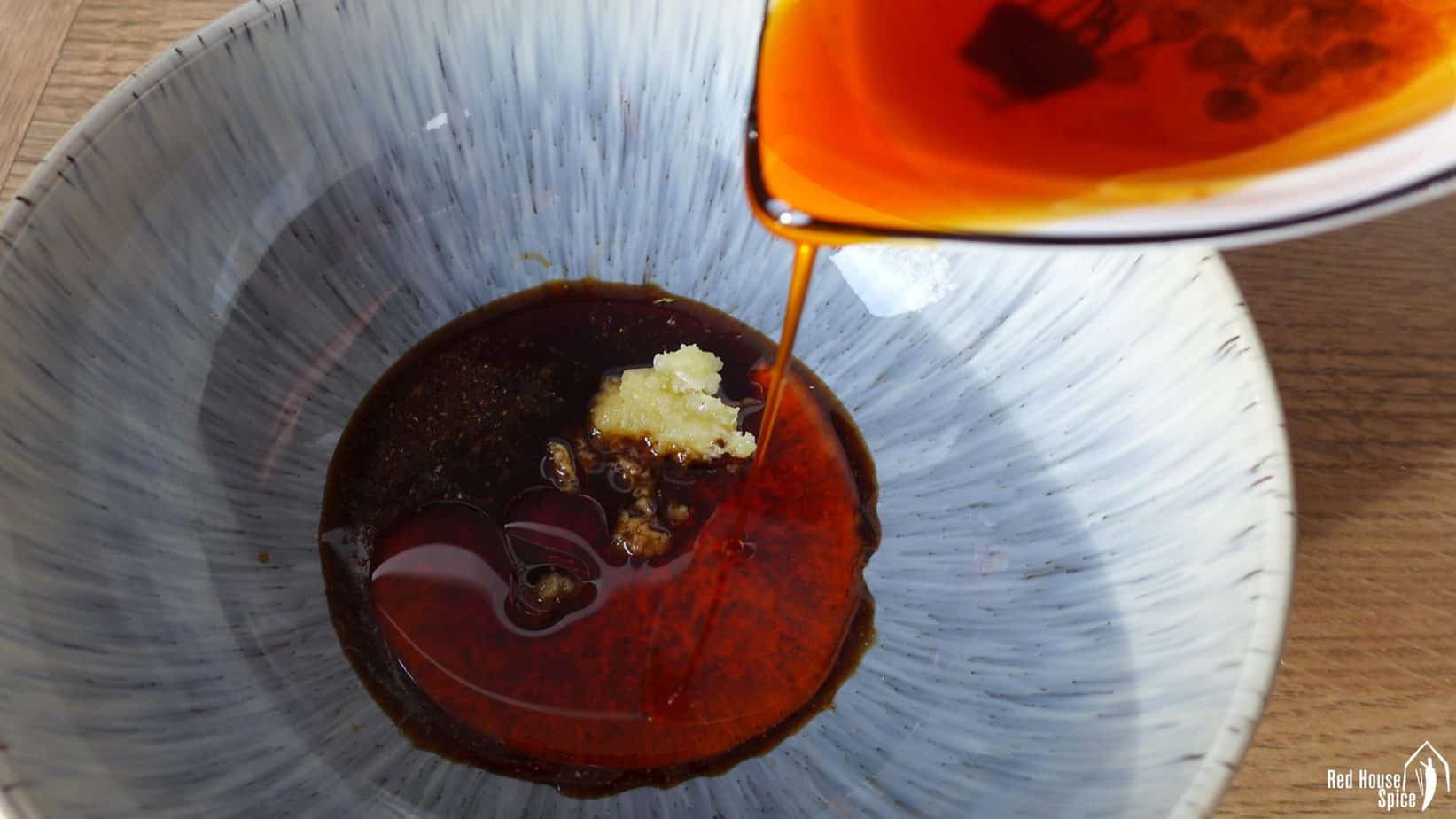
An authentic bowl of Chongqing noodles may look super spicy due to the vibrant red colour of the broth. However, it might not always be as hot as you’d imagine. But the chilli oil in the bowl is super aromatic which makes the dish irresistible.
Why not make your own Chinese chilli oil following my recipe? Believe me! It’s worth the effort. Another benefit is that you have control over the heat level by using chilli flakes/powder of your choice.
Use freshly ground Sichuan pepper
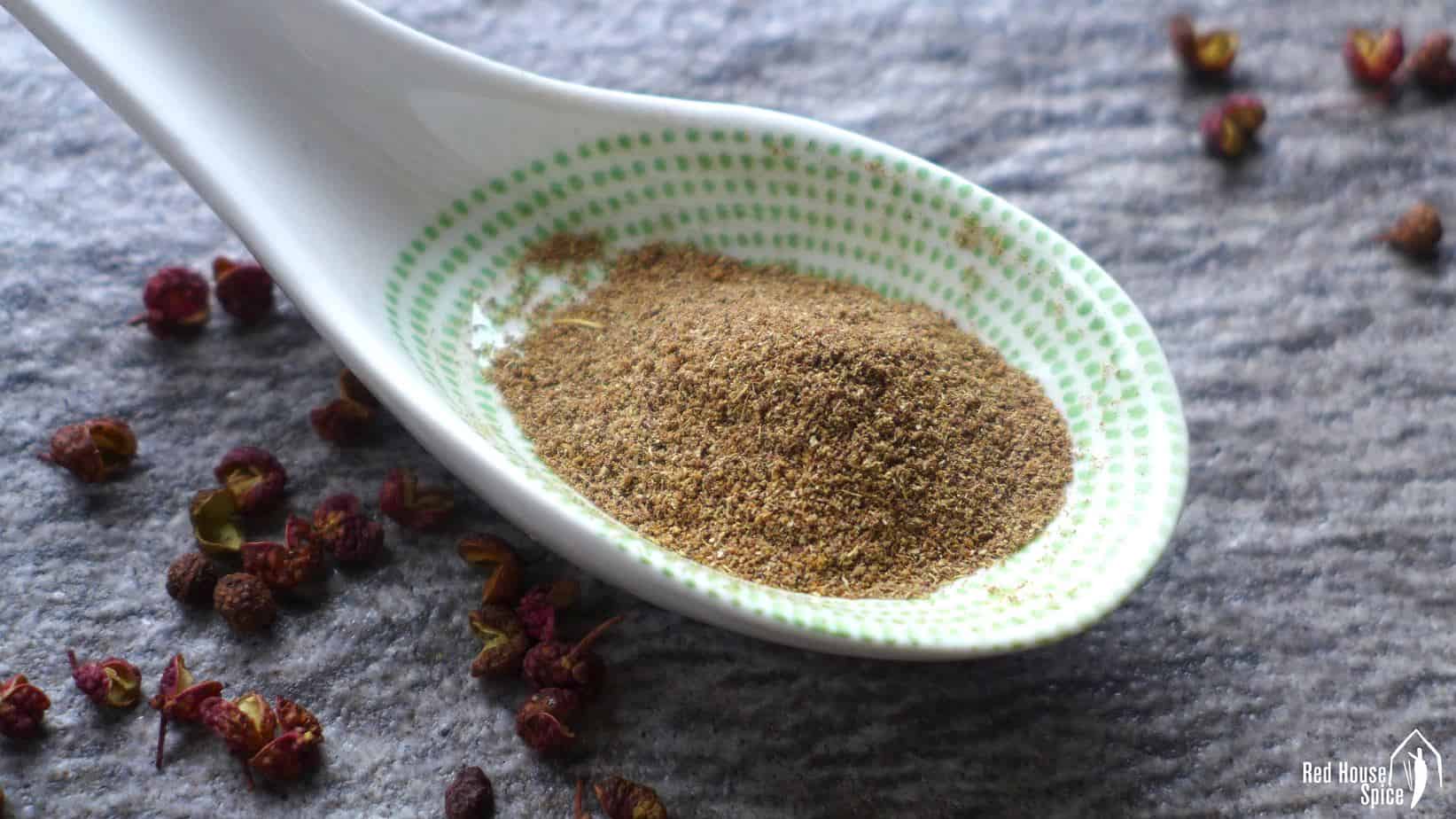
Sichuan pepper powder is indispensable for Chongqing noodles. The mouth-numbing effect provided by this unique spice is indeed an acquired taste. Add a tiny amount to your broth if you are new to it. I’m sure you would demand more once you gradually get used to it.
When possible, grind Sichuan pepper yourself instead of using a shop-bought version which is often too mild in taste. You can find more information on this spice and grinding recipe in my blog post: How to grind Sichuan pepper correctly.
Use umami rich stock
Most Chongqing noodle chefs add MSG (味精), a type of flavour enhancer (aka gourmet powder), to boost the umami taste of the broth. Alternatively, use good quality stock to achieve the same effect. Chicken, beef or vegetable, please feel free to make your own choice. If using unsalted stock, add a little salt to the broth if needed.
What are the toppings
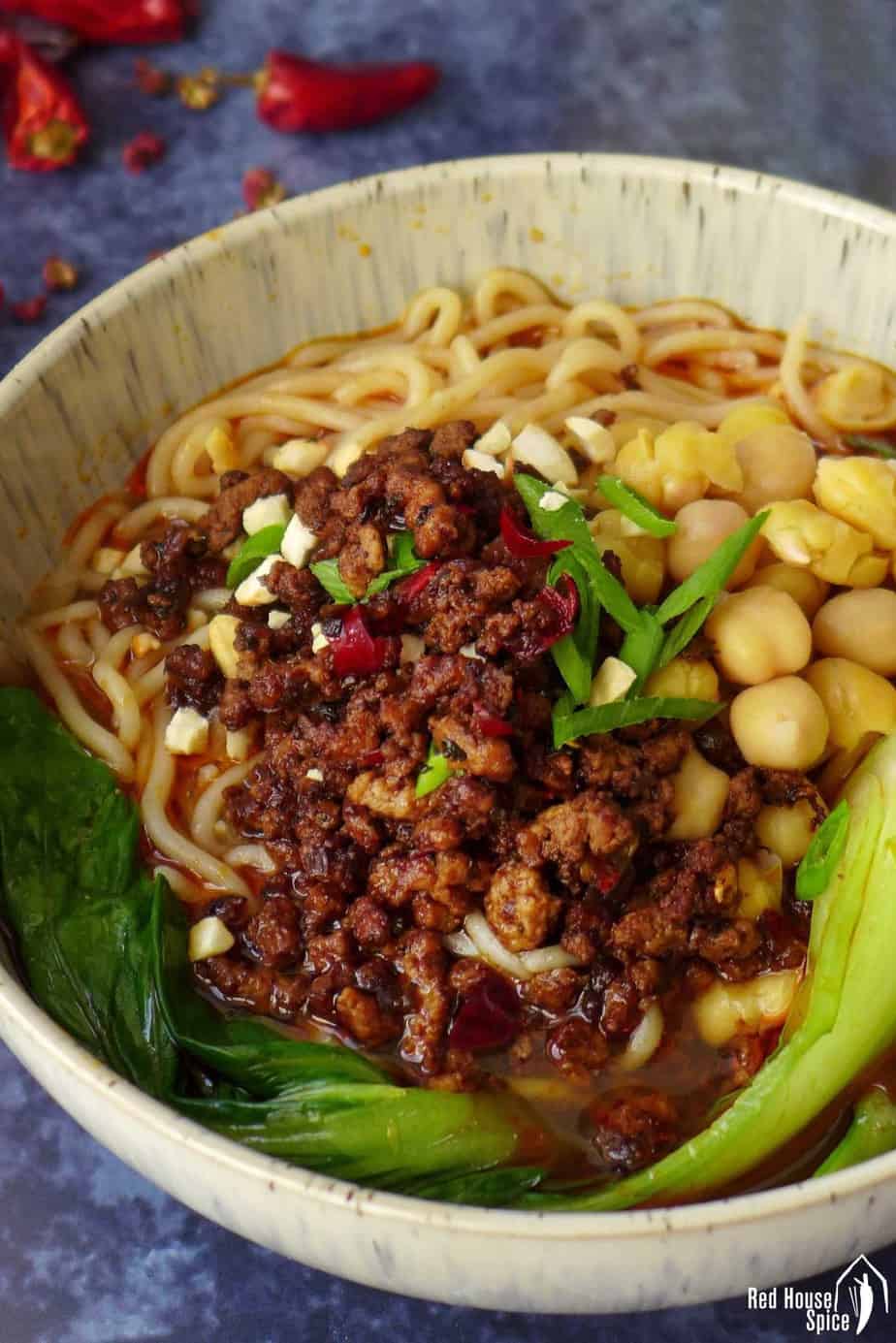
Based on the simple version, street cafes have over time introduced various toppings to Chongqing noodles making it more versatile and attractive. The common toppings include yellow peas, fried ground meat, red-cooked beef, braised pig’s intestines, etc.
My recipe is for one of the most popular types named Wān Zá (豌杂面). Wān/豌 refers to cooked yellow peas and Zá/杂 is an abbreviation of Zá Jiàng/杂酱 which means minced meat fried with spices and bean sauce.
Make tasty meat topping
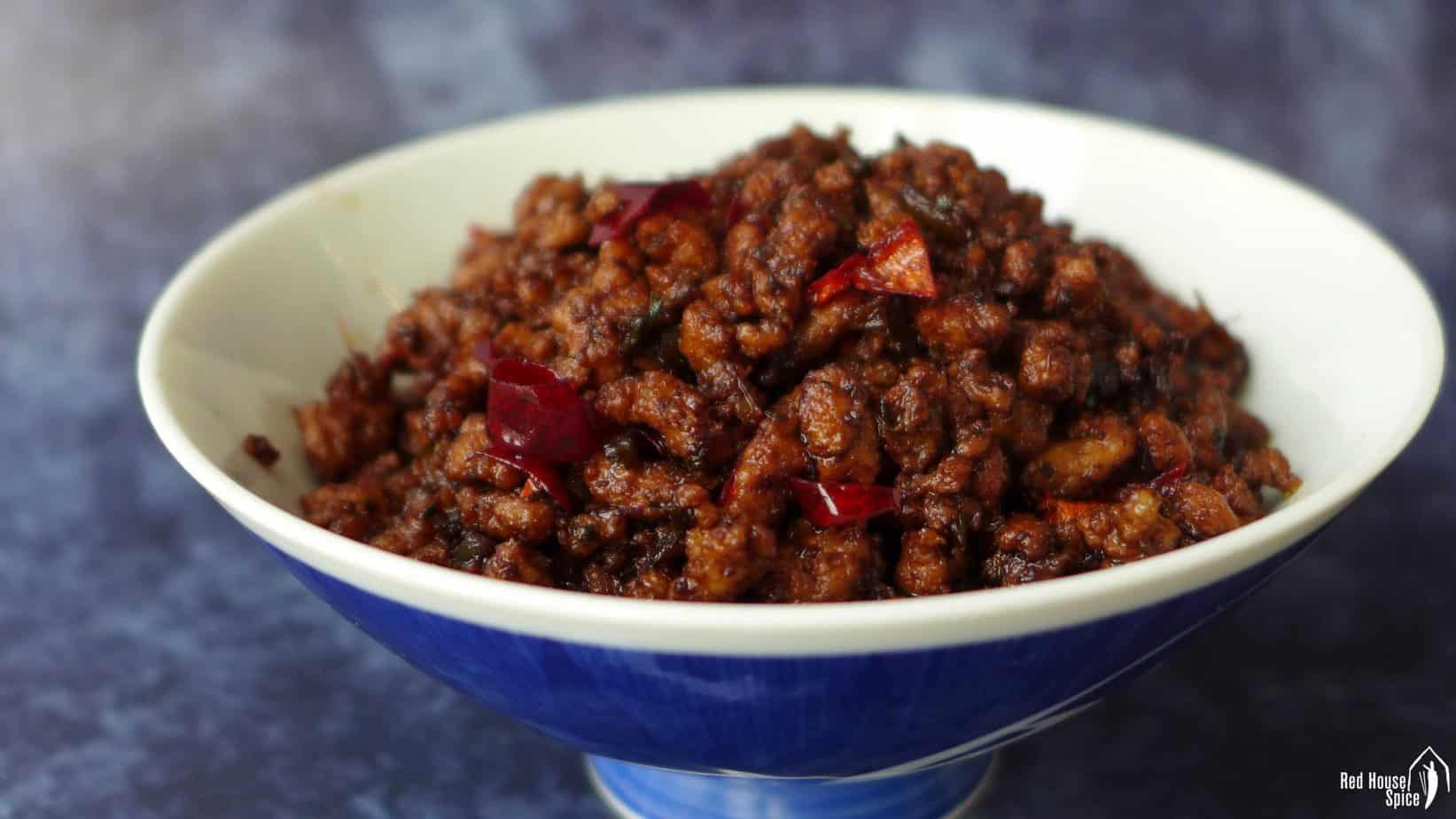
You may use either minced pork or minced beef for this recipe. To make it super tasty, you will need the following ingredients when frying.
- Add Chinese preserved vegetables, such as Ya Cai (芽菜, preserved mustard greens) or Zhai Cai (榨菜, preserved mustard stem). Chop them into tiny pieces if needed.
- Use sweet bean sauce (Tián Miàn Jiàng, 甜面酱) to enhance the flavour and coat the meat with appetizing colour. This can be replaced by soybean paste (Huáng Dòu jiàng, 黄豆酱) or Sichuan chilli bean paste (aka spicy Doubanjiang/辣豆瓣酱).
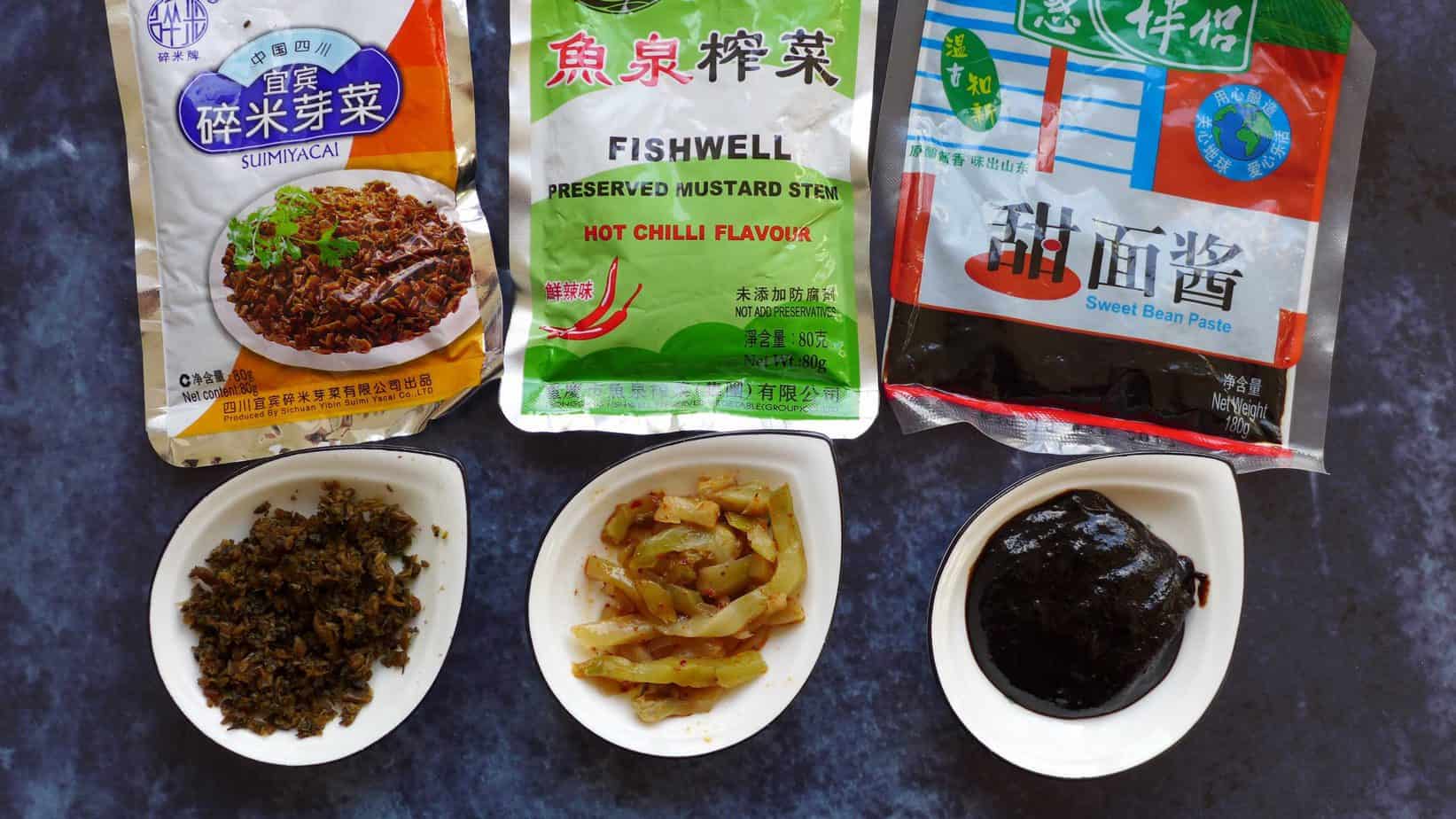
As shown in the image above, these special Chinese ingredients usually come in small-sized plastic packages and are available in most Chinese/Asian shops.
Chickpea as a substitute
Living in Europe, I don’t have easy access to dried whole yellow peas but I’ve found a perfect substitute: canned chickpeas. Not only do they look alike in colour and size, but the texture and flavour are also quite similar too. I like to cook them a little in stock to make them mushier.
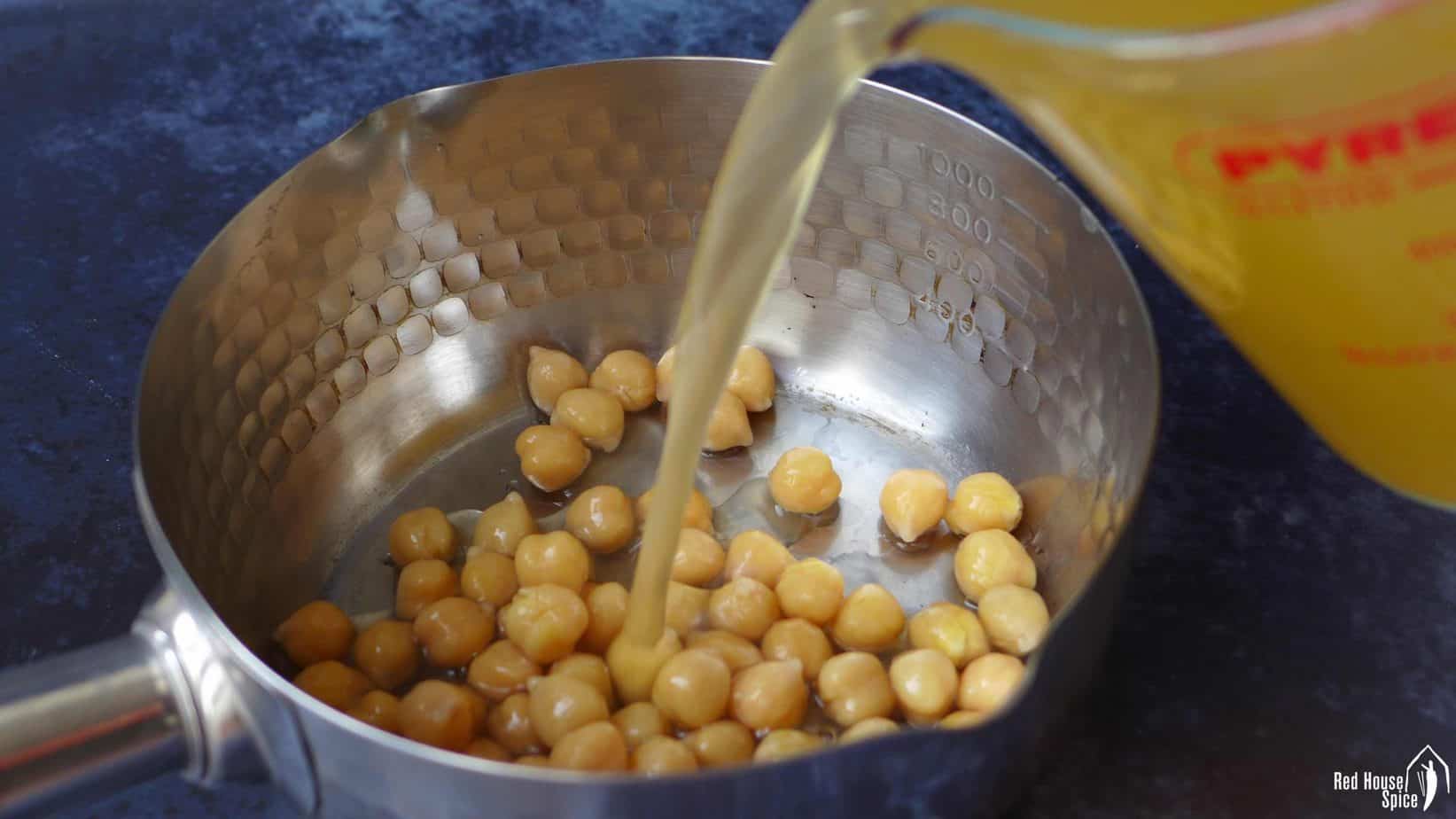
If you do have dried whole yellow peas available, soak them overnight then cook in stock until mushy on the surface.
Which type of noodles
Any type that you like! What makes Chongqing noodles stand out is their distinctive, addictive flavour. So the type of noodles used doesn’t affect the overall brilliance of this dish.
Fresh alkaline noodles

Traditionally Chongqing noodles call for wheat-based, fresh alkaline noodles (Jian Mian, 碱面) which have an excellent texture: slippery, springy and elastic. When I have time, I make them using a noodle/pasta machine.
Dried noodles
When using dried noodles for this dish, I prefer plain ones which don’t contain any egg. Round shaped is my favourite. Follow the cooking instructions on the package. Try not to overcook the noodles as this produces excessive starch which might impair the taste of the broth.
Gluten-free rice noodles
Want to make this dish gluten-free? Use rice noodles (see example in Easy Chow Mei Fun) or glass noodles (see example in Hot and Sour Noodle Soup) which don’t contain any gluten.
Other noodle dishes to try
📋 Recipe card
Love this recipe? Please leave a 🌟🌟🌟🌟🌟 rating and a comment. Thank you!
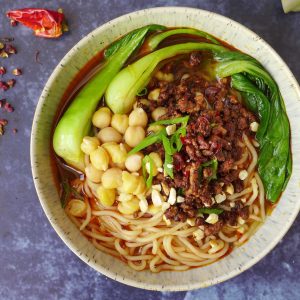
Chongqing Noodles (Xiao Mian, 重庆小面)
Ingredients
For the meat topping
- 1 tablespoon cooking oil
- 3.5 oz ground pork - or beef
- 1 teaspoon minced ginger
- 1 tablespoon minced Ya Cai - or Zha Cai (see note 1)
- 1 pinch dried chilli flakes
- 1 teaspoon Shaoxing rice wine
- 2 teaspoon sweet bean sauce - aka Tian Mian Jiang (see note 2)
Noodles & vegetable
- 7 oz dried noodles - see note 3
- 1 handful leafy green - eg. bok choy, water spinach, choy sum, etc.
For the broth
- 1¼ cup chicken/beef/vegetable stock - see note 4
- 3.5 oz canned chickpeas, drained - see note 5
- 2 tablespoon light soy sauce
- 2 teaspoon black rice vinegar
- 2 tablespoon Chinese chilli oil - or to taste
- ½ teaspoon ground Sichuan pepper - or to taste
- 1 teaspoon minced garlic
- 1 teaspoon minced ginger
- ½ teaspoon sesame oil
- 1 pinch sugar
For the garnish
- 1 tablespoon roasted peanuts/cashews - crushed
- 1 tablespoon finely chopped scallion
Instructions
Cook the meat topping
- Heat up oil in the wok over high heat. Stir in minced meat and ginger.
- Loosen the meat with a spatula. When it turns pale, add Ya Cai/Zha Cai (see note 1), dried chilli flakes & Shaoxing rice wine.
- Add sweet bean sauce once the meat becomes dry. Fry for 30 seconds or so to evenly coat the meat. Dish out and leave aside for later use.
Boil the noodles & vegetable
- Bring a pot of water to a full boil. Cook the noodles following the instructions on the package.
- Add the vegetable for a quick blanch then drain everything.
Prepare the broth
- While waiting for the noodles, heat up the chicken stock with chickpeas.
- Mix all the other ingredients for the soup then pour an equal portion into the serving bowls.
Assemble the dish
- Place the noodles and the vegetable in each bowl.
- Add the stock. Top with chickpeas and the cooked minced meat.
- Sprinkle roasted peanuts & scallion.
NOTES
NUTRITION
NUTRITION DISCLOSURE: Nutritional information on this website is provided as a courtesy to readers. It should be considered estimates. Please use your own brand nutritional values or your preferred nutrition calculator to double check against our estimates.

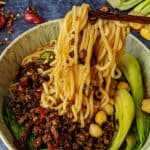
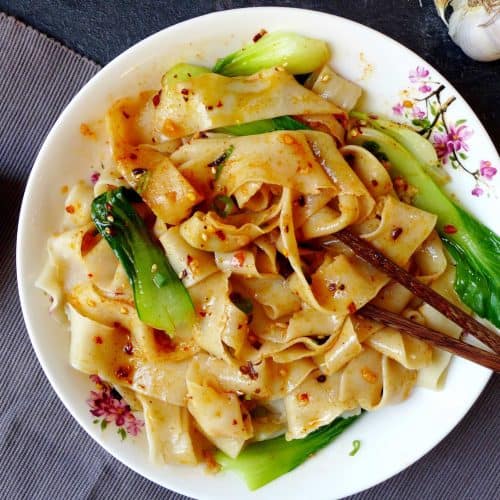

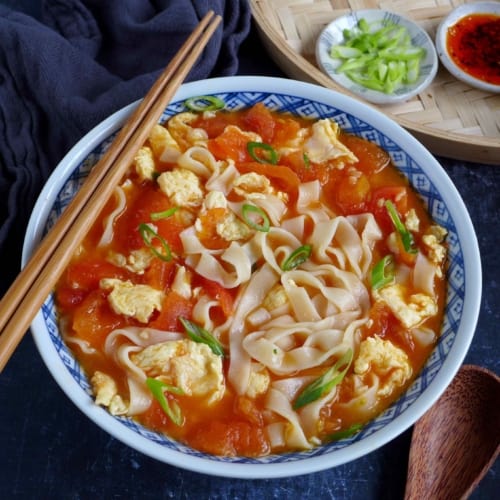
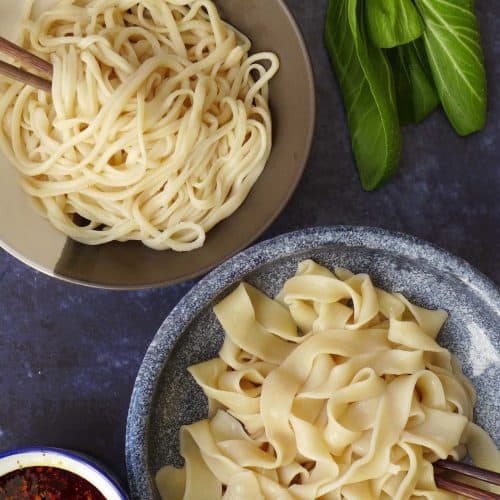

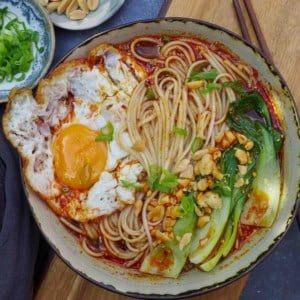
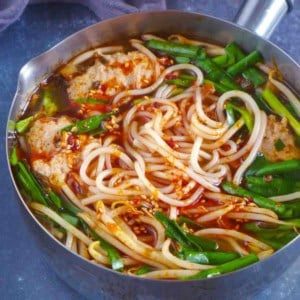
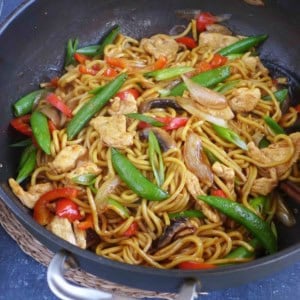
Hello Wei,
I have been longing to make this recipe and although I have all the ingredients I hate waste. The portion that I have is much more than is required in this recipe. How should I store unused Ya Cai? also how long will it last once opened?
Paul:-)
Great question! You can store unused Ya Cai in an airtight container in the fridge. Thanks to its high salt content, it keeps very well — it should last for several months once opened. Just make sure to use a clean utensil each time to avoid contamination. Happy cooking!